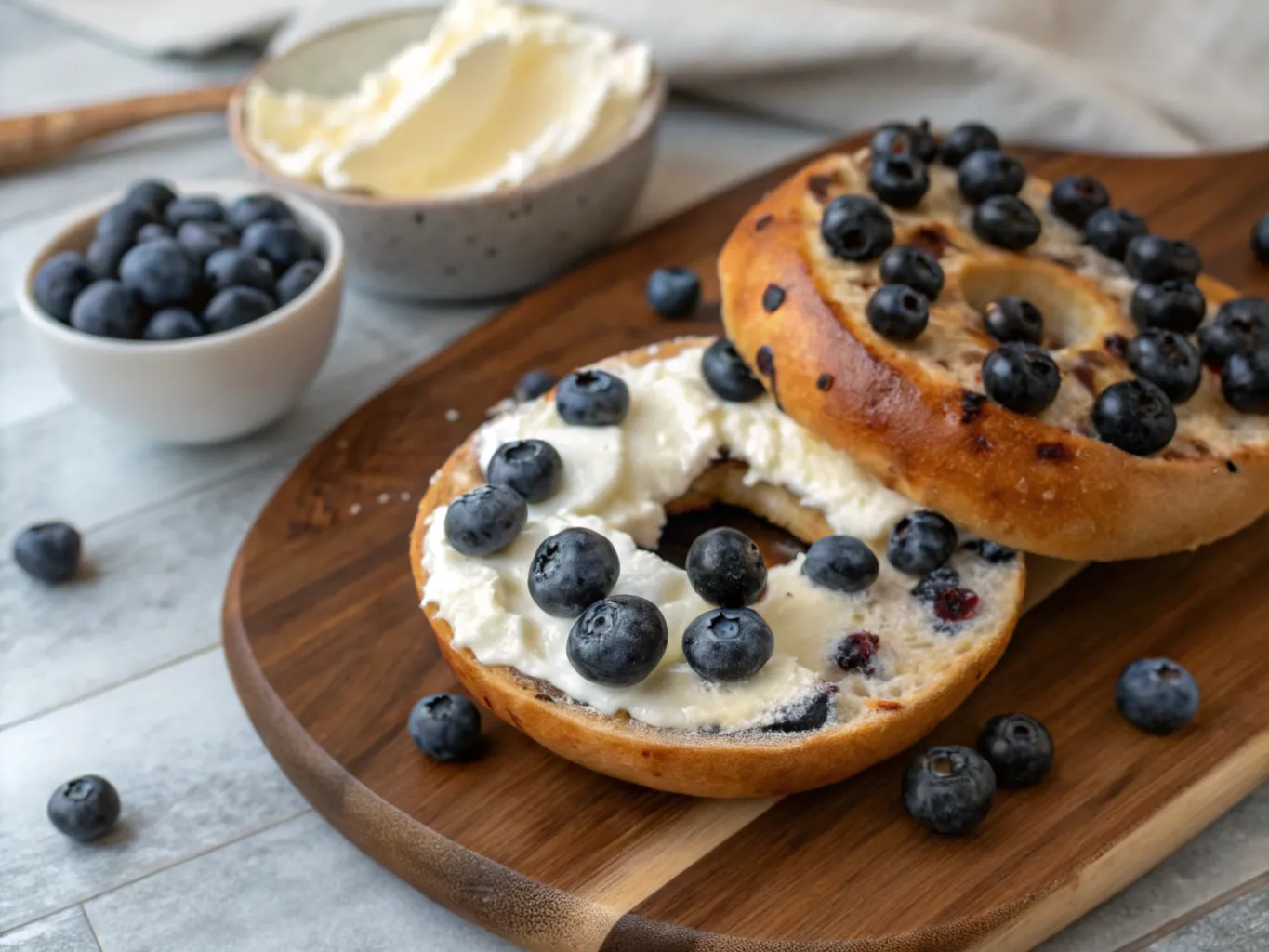Blueberry bagels undeniably hold a special place in the hearts and kitchens of breakfast enthusiasts everywhere. Their irresistible combination of natural sweetness and satisfying texture has made them a staple for those seeking a quick yet indulgent start to the day. However, amidst their widespread popularity, one persistent question arises: “Are blueberry bagels healthy?” While they are undoubtedly delicious, understanding their impact on your health can help you make more informed choices.
In this comprehensive guide, we’ll dive into the nutritional aspects of blueberry bagels, shedding light on their potential health benefits and drawbacks. Additionally, we’ll explore creative ways to make them part of a balanced diet, from ingredient substitutions to mindful topping choices. Whether you’re a bagel enthusiast looking to savor your favorite treat guilt-free or on the hunt for healthier alternatives, this article is here to guide you through everything you need to know about incorporating blueberry bagels, healthy and delicious, into your lifestyle.
Table of contents
What Are Blueberry Bagels Made Of?
To understand their health value, it is essential to begin with the ingredients that make blueberry bagels so appealing. Basically, blueberry bagels combine flour, yeast, sugar, and blueberries. Additionally, while the basic recipe remains straightforward, the quality of ingredients and preparation methods significantly influence their nutritional value. Moreover, these factors play a key role in determining whether blueberry bagels can fit into a balanced diet.
Breaking Down the Ingredients
Let’s look at a typical ingredient list:
| Ingredient | Amount | Notes |
|---|---|---|
| All-purpose flour | 3 cups | Substitute with whole-grain flour for added fiber. |
| Fresh blueberries | 1 cup | Frozen blueberries work just as well. |
| Sugar | 2 tablespoons | Use a natural sweetener for a healthier twist. |
| Yeast | 1 packet | Essential for a soft, airy texture. |
| Water | 1 cup | Warm water activates the yeast. |
| Salt | 1 teaspoon | Balances flavor and enhances sweetness. |
Each ingredient plays a role in creating the flavor and texture we love. However, there are ways to make adjustments for health-conscious eaters. For instance, switching to whole-grain flour increases fiber content, while reducing sugar keeps calories in check.
Why Ingredients Matter
Blueberries are often considered a superfood, and their inclusion in bagels adds antioxidants, vitamins C and K, and dietary fiber. These nutrients support overall health by reducing oxidative stress, boosting immunity, and improving digestion. Similarly, using quality flour, such as whole-grain, can add nutrients like B vitamins and iron, making blueberry bagels, healthy and nutritious for your daily diet.
Making Healthier Choices
If you’re preparing bagels at home, consider adding flaxseed or chia seeds to the dough for an omega-3 boost. Alternatively, use almond or oat flour for gluten-free options that maintain a similar flavor profile.
How Many Calories Are in a Blueberry Bagel?
One of the most frequently asked questions about blueberry bagels is their caloric content. On average, a medium-sized blueberry bagel contains:
- Calories: 280-350
- Carbohydrates: 55-60g
- Protein: 9-11g
- Fat: 1-2g
These numbers can vary depending on the size and ingredients. Toppings also play a significant role. For example, adding cream cheese or butter can increase calories by 100-150 per serving.
Nutritional Comparisons
Compared to plain bagels, blueberry bagels offer a slight edge due to the antioxidants in blueberries. However, whole-grain bagels are often healthier because they provide more fiber and fewer refined carbs.
Discover creative ways to make bagels healthier with this guide to blueberry bagel toppings. It’s packed with ideas for delicious, nutritious spreads and garnishes.

Are Blueberry Bagels Good for You?
The answer to whether blueberry bagels are good for you depends on how they fit into your overall diet. While they’re not inherently unhealthy, moderation and smart choices are key.
Benefits of Blueberries
Blueberries undeniably serve as the nutritional powerhouse in these bagels. Moreover, they contain antioxidants and vitamins that help combat inflammation. Additionally, they support heart health and may even improve brain function. Therefore, including blueberries in your diet significantly contributes to long-term wellness.
Balancing Macronutrients
While blueberry bagels provide quick energy from carbohydrates, they’re low in protein and healthy fats. To create a balanced meal, pair your bagel with a protein-rich side like eggs or Greek yogurt. Adding avocado as a topping can introduce healthy fats to the mix.
Choosing Whole Grains
Whole-grain blueberry bagels are a healthier choice compared to their refined flour counterparts. They contain more fiber, which aids digestion and helps you feel fuller for longer.
What Is the Healthiest Bagel to Eat?
Not all bagels are created equal. While traditional blueberry bagels are a tasty treat, there are several ways to make them healthier:
- Whole-Grain Bagels: High in fiber and nutrients, these bagels are better for digestion and heart health.
- Low-Carb Options: Using almond or coconut flour reduces carbs, making these ideal for keto diets.
- Gluten-Free Varieties: Perfect for those with gluten intolerance, these are made with alternative flours like rice or almond flour.
Tips for Healthier Bagels
- Limit Sugar: Many bagels contain added sugars. Opt for recipes that rely on the natural sweetness of blueberries.
- Portion Control: Bagels are calorie-dense, so consider eating half a bagel with a protein-rich side.
- Avoid High-Calorie Toppings: Instead of cream cheese or butter, try low-fat spreads, hummus, or almond butter.
Get started on a healthier path by trying this blueberry bagel recipe. It includes tips for reducing sugar and boosting nutrients.
Are Bagels Healthy for Weight Loss?
Bagels, including blueberry ones, are often seen as a “cheat meal” in weight-loss diets. However, they can still fit into a healthy plan when eaten mindfully.
Portion Sizes Matter
Most bagels are equivalent to 2-3 servings of bread. To keep your meal balanced, try eating half a bagel and pairing it with protein or fiber-rich foods.
Whole-Grain Benefits
Whole-grain bagels digest more slowly than refined flour ones, helping to control blood sugar levels. This makes them a better option for sustained energy.
Smart Topping Choices
High-calorie toppings can quickly make bagels less weight-loss friendly. Instead, opt for:
- Low-Fat Cream Cheese: Adds flavor without too many calories.
- Avocado Slices: Provides healthy fats and fiber.
- Nut Butters: Use sparingly for a protein boost.
How to Make Blueberry Bagels Step-by-Step
Blueberry bagels are a delightful addition to any breakfast table, and making them at home ensures you can control the ingredients for a healthier twist. Whether you’re an experienced baker or a beginner, this step-by-step guide will walk you through the process of creating perfectly chewy and flavorful blueberry bagels, healthy enough to fit into your balanced diet.
Step 1: Preparing the Dough
The foundation of any good bagel lies in its dough. Start by combining the dry ingredients in a mixing bowl. Gradually add warm water and knead the mixture until it forms a soft, elastic dough. Incorporate blueberries during the final stages of kneading to distribute them evenly without crushing them, ensuring your blueberry bagels, healthy and flavorful are perfectly prepared for baking.
- Pro Tip: For vibrant bursts of blueberry flavor, freeze the blueberries before adding them to the dough. This prevents them from bleeding into the mix.

Step 2: Shaping the Bagels
After the dough has risen, divide it into equal portions. Roll each portion into a smooth ball, then use your thumb to create a hole in the center. Stretch the dough gently to form the classic bagel shape.
- Pro Tip: To ensure even sizes, weigh the dough portions before shaping. Aim for consistency to achieve uniform baking.
Step 3: Boiling the Bagels
The boiling step, importantly, creates the bagels’ chewy texture. Therefore, bring a large pot of water to a gentle boil and, additionally, add a tablespoon of honey or brown sugar. Subsequently, boil the bagels for 1–2 minutes per side, and then remove them with a slotted spoon. Finally, place them on a parchment-lined baking sheet.
Learn more about the science behind boiling bagels by exploring this detailed blueberry bagel recipe.
Step 4: Baking the Bagels
Preheat your oven to 375°F (190°C). Place the boiled bagels on a baking sheet, ensuring they are spaced apart. Bake for 20-25 minutes or until they develop a golden-brown crust.
- Pro Tip: For a glossy finish, brush the bagels with an egg wash before baking.

Pro Tips & Variations
Adding personal touches to your bagels, undoubtedly, elevates them from great to extraordinary. Whether you prefer classic flavors or, alternatively, want to experiment with unique twists, here are some ideas to inspire you.
Tips for Perfect Bagels
- Use Bread Flour: Its higher protein content results in chewier bagels with a robust texture.
- Add Zest: Incorporate lemon or orange zest into the dough for a citrusy kick.
- Control the Sweetness: Adjust the amount of sugar to suit your preference, or use natural sweeteners like agave syrup.
Creative Variations
- Vegan Blueberry Bagels: Replace dairy-based ingredients with plant-based milk and vegan butter for a fully vegan option.
- Whole-Grain Bagels: Swap half the all-purpose flour with whole-wheat flour to boost fiber content.
- Dessert-Inspired Bagels: Drizzle melted white chocolate over the baked bagels for a decadent treat.

FAQs: Answering Your Questions
Are blueberry bagels good for you?
Yes, blueberry bagels can be a nutritious choice when prepared with wholesome ingredients. The blueberries add antioxidants and vitamins, while whole-grain flour increases fiber content. However, moderation is key to managing calorie intake.
What is the healthiest type of bagel to eat?
Whole-grain bagels are the healthiest option due to their high fiber content. Adding nutrient-rich ingredients like blueberries enhances their nutritional value.
Are bagels healthy for weight loss?
Bagels can be included in a weight-loss plan if eaten mindfully. Choose smaller portions, opt for whole-grain varieties, and avoid calorie-dense toppings like cream cheese or butter.
How many calories are in a blueberry bagel?
A typical blueberry bagel contains 280-350 calories. The exact count depends on the size and specific ingredients used. Adding toppings can increase the calorie content.
Can you make low-calorie blueberry bagels?
Yes! Use whole-grain or almond flour, reduce sugar, and substitute traditional sweeteners with low-calorie options like stevia to create a lighter version.
Are homemade blueberry bagels healthier than store-bought?
Absolutely. Homemade bagels are healthier because you can control the quality of ingredients, reduce preservatives, and adjust the recipe to fit your dietary needs.
Conclusion
Adding personal touches to your bagels, undoubtedly, elevates them from great to extraordinary while making them truly your own. Whether you prefer classic flavors for timeless appeal or, alternatively, want to experiment with creative and bold twists, the possibilities are endless. Therefore, consider toppings, fillings, or even seasoning blends to transform your bagels into something memorable. Moreover, here are some ideas to inspire your next creation and, specifically, help you infuse personality into every bite.

